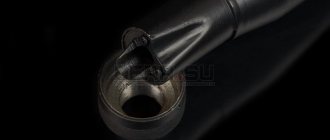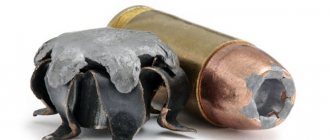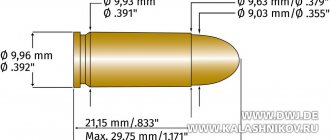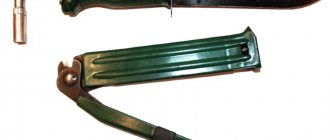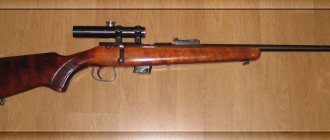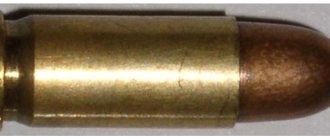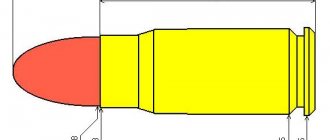Russian cartridges
The use of combined arms weapons for silent shooting requires the availability of cartridges with a reduced (to subsonic) muzzle velocity and a muzzle silencer. An example is the AKM assault rifle with LAN-1 and 7.82 US cartridge. Pistols and submachine guns chambered for standard pistol cartridges for silent shooting must also be equipped with a muzzle silencer. All this leads to an increase in the size and weight of the weapon, which is not always acceptable when conducting special operations. Since the 1960s, the USSR and Russia have used another principle to ensure silent shooting - locking the powder gases in the cartridge case. According to this principle, several types of cartridges and corresponding silent weapons were created.
7.62 mm PZAM cartridge
7.62 mm PZAM cartridge
The special PZAM cartridge (PZAM is an improved, modernized “snake” cartridge) was created as a further development of the PZ and PZA cartridges in the mid-1960s. It was intended for firing from a special S-4M pistol and ensured covert destruction of living targets at a range of up to 25 m.
Silent and flameless shooting is ensured by cutting off the powder gases in the cartridge case using a special part - a piston-pusher. When fired, the powder gases acting on the piston-pusher impart an initial acceleration to the bullet. Moving forward, the piston becomes wedged in the front of the cartridge case, trapping the powder gases, which are gradually released through microscopic gaps.
The cartridge uses a 7.62 mm bullet from the 57-N-231 cartridge for the AKM assault rifle (an ordinary bullet with a steel core). The walls of the sleeve are made very strong to ensure the safety and reliability of using weapons. The cartridge does not have a distinctive color.
Design of the 7.62 mm PZAM cartridge
Design of the 7.62 mm PZAM cartridge
Main characteristics of the PZAM cartridge
Cartridge mass, g: 15.0 Bullet mass, g: 8.0 Cartridge length, mm: 77 Initial bullet speed, m/s: 200
7.62 mm SPZ cartridge
7.62 mm SPZ cartridge
The SPZ cartridge (SP - special cartridge, third sample) was created at the Federal State Unitary Enterprise "TsNII TOCHMASH" in the late 1960s, with the aim of reducing the size of the silent pistol. It was intended for firing from a small-sized special pistol SME and a special reconnaissance knife NRS and ensured the hidden destruction of living targets at a range of up to 25 m.
Silent and flameless shooting is ensured by cutting off the powder gases in the cartridge case. Unlike the PZAM cartridge, the piston-pusher is made telescopic. The SPZ cartridge in its external outline resembles the 7.62 mm cartridge mod. 1943, but has smaller dimensions.
Design of the 7.62 mm SP3 cartridge
Main characteristics of the SP3 cartridge
Cartridge mass, g: 15 Bullet mass, g: 7.9 Cartridge length, mm: 52 Initial bullet speed, m/s: 150
7.62 mm pistol cartridge SP4
7.62 mm pistol cartridge SP4
The 7.62 SP4 cartridge (SP is a special cartridge, the fourth sample) with cut-off of powder gases in the case was developed at the FSUE "TsNII TOCHMASH" in the mid-1980s to replace the PZ, PZA, PZAM and SPZ cartridges, with the goal of creating a self-loading silent pistol small dimensions and weight. The production of the cartridge was mastered at the Klimovsky Special Cartridge Plant.
The bullet of the SP4 cartridge is a steel cylinder onto which a driving belt is pressed. When cartridgeed, the bullet is completely buried in the cartridge case. Behind the bullet there is a short piston-pusher, which, when fired, locks the powder gases in the cartridge case. After the shot, the piston does not protrude beyond the dimensions of the cartridge case, which ensures reliable operation of the automatic pistol.
The 7.62 SP4 cartridge is designed for firing from a special self-loading pistol PSS, a special reconnaissance knife NRS-2 and an OTs-38 revolver and provides covert destruction of living targets at a distance of up to 25 m. At the same time, a high degree of muting the sound of the shot is ensured.
The cartridge does not have a distinctive color.
Design of the 7.62 mm SP4 pistol cartridge
Main characteristics of the SP4 cartridge
Cartridge mass, g: 23 Bullet mass, g: 10 Cartridge length, mm: 42 Initial bullet speed, m/s: 200
7.62 mm pistol cartridge 7N36
7.62 mm pistol cartridge 7N36
The 7N36 cartridge was created as an analogue of the 7.62 SP4 cartridge at the Automatic Lines Design Bureau in the early 2000s. The purpose of its development was to improve the manufacturability of production. The production of the cartridge was mastered by the Tula Cartridge Plant.
The bullet of the 7N36 cartridge, unlike the SP4 cartridge, has a bimetallic shell which houses a steel core, similar to the bullet core of the SP4 cartridge. Guidance of the bullet along the rifling in the barrel is ensured not by the leading belt or lead jacket, but by the bullet shell thickened in the front part. Otherwise, the design of the 7N36 cartridge is the same as the 7.62 SP4 cartridge. The 7N36 cartridge is designed for firing from a special self-loading pistol PSS, a special reconnaissance knife NRS-2 and an OTs-38 revolver and provides covert destruction of living targets at a distance of up to 25 m. At the same time, as in the SP4 cartridge, a high degree of muting the sound of the shot is ensured.
The cartridge does not have a distinctive color.
Design of the 7.62 mm pistol cartridge 7N36
Main characteristics of the 7N36 cartridge
Cartridge mass, g: 23 Bullet mass, g: 10 Cartridge length, mm: 42 Initial bullet speed, m/s: 200
« back | menu | forward "
The longest: needle bullets for an underwater assault rifle
By the early 1970s, TsNIITochmash had completed work on a special cartridge for underwater use, which was used to equip the APS underwater assault rifle. This cartridge resembles an arrow - its length is as much as 15 centimeters, which is three times longer than the length of a regular cartridge for a Kalashnikov assault rifle.
Photo: Rosoboronexport
Underwater, the killing power of a 5.66 mm needle-shaped bullet depends on the depth. At five meters under water, the target can be hit at a distance of 30 meters, at a diving depth of 20 meters, it can be hit at a distance of 20 meters, and at a depth of 40 meters, the hitting range is only 10 meters. But even at extreme firing ranges, such a bullet can hit an enemy in a wetsuit or pierce organic glass up to 5 mm thick.
The underwater APS is also applicable on land, but in the air this machine gun is only suitable for self-defense - it fires at a range of up to 100 meters. Designed to deal with flood conditions, the weapon's mechanism quickly wears out on land - the machine gun is enough for only 180 shots.
Specifications
The weight of the cartridge is 23 grams, the bullet weighs 10 grams. The cartridge uses Sf040 smokeless pyroxylin gunpowder. The bullet for the cartridge is of a shellless type, its length is 28.5 mm, the length of the sleeve is 42 millimeters. The initial bullet speed is 200 m/s. The muzzle energy of the bullet is 338 Joule. The maximum pressure of powder gases is 287.3 MPa, the ballistic coefficient of the bullet is 6.62 m2/kg.
The original ammunition remains in service today. This is one of the most popular silent pistol kits, reliable and easy to use. This, as well as its relatively low cost, is the reason for its popularity and fame.
PSS Vul
Published by admin on Sun, 03/07/2010 – 22:04
Silent pistol PSS Vul, 1983, Russia
Tactical and technical characteristics of PSS Vul USM - double action Caliber, mm - 7.62×41 mm SP-4 Length, mm - 170 Height, mm - 140 Width, mm - 26 Length of the rifled part of the barrel, mm - 35 (with chamber, mm - 71) Number of rifling, pcs – 4 Sighting line length, mm – 130 Pistol weight, g: unloaded – 700 loaded – 850 Sighting range, m – 25 Sighting line length, mm – 130 Initial bullet speed, m/s – 200 Effort release no more, kgf: with combat cocking/self-cocking – 3.5/8.5 Accuracy of fire R100, cm, no more – 12.5 Magazine capacity – 6
The new silent PSS complex (official index 6P28, code designation during development “Vul”) with automatic reloading and 7.62x41.5 silent SP-4 cartridge was developed by TsNIITochMash by designers Yu. Krylov and V. Levchenko.
Its unique design allowed domestic special forces to obtain small-sized, silent weapons, ready to immediately open fire. In 1983, it was adopted by the special forces of the Ministry of Defense and the KGB under the designation PSS (special self-loading pistol).
The smallest: tiny but “evil” cartridge
One of the unique domestic developments is the PSM (small-sized self-loading pistol) of 5.45 mm caliber. This compact model was created for employees of the KGB and the Ministry of Internal Affairs in 1974. Even today, PSM is in no way inferior to its modern small-sized “brothers”. What made it popular were such qualities as reliability, reliability, accuracy, and, of course, compact size. PSM is considered the flattest production pistol in the world - its width does not exceed 18 mm.
Photo: Rosoboronexport
To make such a small pistol an effective weapon, TsNIITochmash designers needed to create a completely new miniature cartridge. This is how the “small-sized central firing cartridge” or MPC appeared. This 5.45x18 mm caliber cartridge is the smallest ammunition in service with the Russian army. Despite its modest size, the cartridge turned out to be quite “evil” - the PSM can penetrate body armor up to the second class of protection.
First luminous: hunting cartridge with light element
Recently, engineers of the Technodinamika holding company created an innovative hunting cartridge, which was called the “Plume-Vector”. According to the developers, the product has no Russian or foreign analogues. Its uniqueness lies in the presence of a light element, which allows you to visualize the flight of a shot shell and adjust the accuracy of the shot.
Video: Technodynamics
The ammunition contains a special container that combines a projectile with shot and a light element. When fired, the container splits into three parts, releasing an ignited red light element that follows the shot, demonstrating its flight path up to approximately 85 meters.
The features of the “Plume-Vector” allow it to be used for shooting not only from classic single-barreled, double-barreled or pump-action shotguns, but also from smooth-bore weapons with gas-operated or inertial automatics. The new cartridge can be used in 12-gauge weapons with a chamber length of 70 mm or more.
OTs-38
Published by admin on Sun, 12/20/2009 – 20:50
7.62 mm special revolver Stechkin / OTs-38, 2002, Russia
Tactical and technical characteristics of OTs-38 USM - double action Caliber, mm - 7.62 (SP-4) Weight without cartridges, kg: without laser pointer - 0.82 with laser pointer - 0.88 Overall dimensions, mm: - 191x40.2x140 Power supply for laser control center – battery D-0.03D (3 pcs.) Drum capacity, cartridge. - 5
The silent revolver OTs-38 was developed by the now deceased Igor Yakovlevich Stechkin at TsKIB SOO (now a branch of the Instrument Design Bureau, Tula). The OTs-38 was developed as an alternative to the PSS silent pistol chambered for the same silent special SP-4 cartridge, and is intended to arm FSB operatives and other Russian law enforcement agencies. The OTs-38 revolver is produced in small batches on special orders.
Double Strike: Cartridge with two bullets
In the mid-1970s, domestic designers began to think about creating multi-bullet large-caliber ammunition. It was not difficult to justify the need for this development - it is obvious that a two-bullet cartridge doubles the density of fire, even without increasing the rate of fire of machine guns. One can only imagine the effect of five bullets. However, the idea of multi-bullet still settled on two bullets. Even at the stage of preliminary calculations, it became clear that it was almost impossible to launch a larger number of projectiles simultaneously without losing the reliability of the weapon.
Photo: Kalashnikov Concern
As a result, the developers of TsNIITochmash chose a two-pullet version - the project was called “Theorist”. The result of the work was 12.7×108 mm 1SL and 1SLT (tracer) cartridges. They were adopted into service in 1984, but were not widely used. In particular, the military was not satisfied with the reduced penetration ability and large dispersion of bullets.
"Plagiarism"?
It is unknown whether Soviet gunsmiths borrowed Bissel’s idea to make their silent ammunition or not. The first proprietary technologies, according to Ftimes.ru journalists, began to appear in the arsenal of specialists from the Soviet era even before the start of the Second World War. Then the Gurevich silent cartridge was created. The principle of operation of the ammunition is almost the same as that previously patented by the American. It is impossible to say reliably whether the Soviet developers then resorted to “plagiarism” or not; most likely it will remain a secret.
